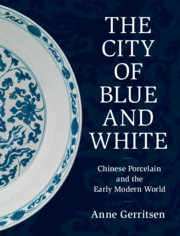Book contents
- The City of Blue and White
- The City of Blue and White
- Copyright page
- Dedication
- Contents
- Figures
- Maps
- Table
- Acknowledgements
- 1 The Shard Market of Jingdezhen
- 2 City of Imperial Choice: Jingdezhen, 1000–1200
- 3 Circulations of White
- 4 From Cizhou to Jizhou: The Long History of the Emergence of Blue and White Porcelain
- 5 From Jizhou to Jingdezhen in the Fourteenth Century: The Emergence of Blue and White and the Circulations of People and Things
- 6 Blue and White Porcelain and the Fifteenth-Century World
- 7 The City of Blue and White: Visualizing Space in Ming Jingdezhen, 1500–1600
- 8 Anxieties over Resources in Sixteenth-Century Jingdezhen
- 9 Skilled Hands: Managing Human Resources and Skill in the Sixteenth-Century Imperial Kilns
- 10 Material Circulations in the Sixteenth Century
- 11 Local and Global in Jingdezhen’s Long Seventeenth Century
- 12 Epilogue: Fragments of a Global Past
- Notes
- Bibliography
- Index
5 - From Jizhou to Jingdezhen in the Fourteenth Century: The Emergence of Blue and White and the Circulations of People and Things
Published online by Cambridge University Press: 24 February 2020
- The City of Blue and White
- The City of Blue and White
- Copyright page
- Dedication
- Contents
- Figures
- Maps
- Table
- Acknowledgements
- 1 The Shard Market of Jingdezhen
- 2 City of Imperial Choice: Jingdezhen, 1000–1200
- 3 Circulations of White
- 4 From Cizhou to Jizhou: The Long History of the Emergence of Blue and White Porcelain
- 5 From Jizhou to Jingdezhen in the Fourteenth Century: The Emergence of Blue and White and the Circulations of People and Things
- 6 Blue and White Porcelain and the Fifteenth-Century World
- 7 The City of Blue and White: Visualizing Space in Ming Jingdezhen, 1500–1600
- 8 Anxieties over Resources in Sixteenth-Century Jingdezhen
- 9 Skilled Hands: Managing Human Resources and Skill in the Sixteenth-Century Imperial Kilns
- 10 Material Circulations in the Sixteenth Century
- 11 Local and Global in Jingdezhen’s Long Seventeenth Century
- 12 Epilogue: Fragments of a Global Past
- Notes
- Bibliography
- Index
Summary
Jizhou played a key role in the emergence of ceramics brush-painted decorations of iron-oxide pigment. But Jingdezhen became the site where blue and white ceramics were produced, not Jizhou. This chapter asks when and why Jizhou’s production came to an end, and how Jingdezhen could emerge from this period as the most successful production site of the premodern world. The depletion of local clays, the lack of firing success in Jizhou (yaobian-kiln transmutation) and eventually the migration of potters to Jingdezhen all form part of the story of decline in Jizhou. Jingdezhen, nearby, and with an excellent supply of resources, developed into the site with more potential for growth, in terms of technologies, resources and skilled potters. Archaeological and visual evidence, especially the visual language applied of decorative elements visible in the David vases of the mid fourteenth century, and objects produced in Jizhou shortly before then, supports the claim of a close connection between Jizhou and Jingdezhen during this period. This chapter demonstrates that the story of Jingdezhen, usually told as a story of global success, begins with these local and regional interactions.
- Type
- Chapter
- Information
- The City of Blue and WhiteChinese Porcelain and the Early Modern World, pp. 88 - 113Publisher: Cambridge University PressPrint publication year: 2020



